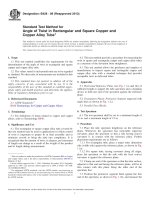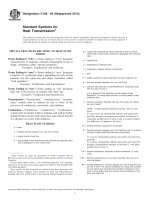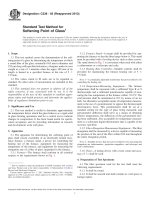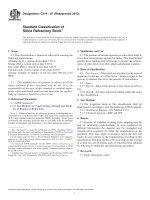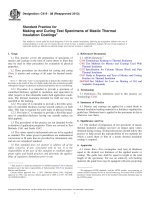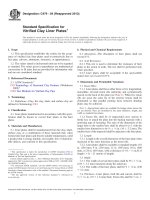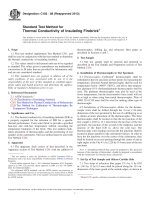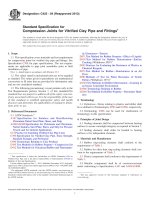Astm c 24 09 (2013)
Bạn đang xem bản rút gọn của tài liệu. Xem và tải ngay bản đầy đủ của tài liệu tại đây (184.78 KB, 5 trang )
Designation: C24 − 09 (Reapproved 2013)
Standard Test Method for
Pyrometric Cone Equivalent (PCE) of Fireclay and High
Alumina Refractory Materials1
This standard is issued under the fixed designation C24; the number immediately following the designation indicates the year of original
adoption or, in the case of revision, the year of last revision. A number in parentheses indicates the year of last reapproval. A superscript
epsilon (´) indicates an editorial change since the last revision or reapproval.
This standard has been approved for use by agencies of the U.S. Department of Defense.
1. Scope
3. Terminology
1.1 This test method covers the determination of the Pyrometric Cone Equivalent (PCE) of fire clay, fireclay brick, high
alumina brick, and silica fire clay refractory mortar by comparison of test cones with standard pyrometric cones under the
conditions prescribed in this test method.
3.1 Definitions—For definitions of terms used in this test
method, see Terminology C71.
4. Summary of Test Method
4.1 This test method consists of preparing a test cone from
a refractory material and comparing its deformation end point
to that of a standard pyrometric cone. The resultant PCE value
is a measure of the refractoriness of the material.
1.2 Units—The values stated in inch-pound units are to be
regarded as standard. The values given in parentheses are
mathematical conversions to SI units that are provided for
information only and are not considered standard.
1.2.1 Exceptions—Certain weights are in SI units with
inch-pound in parenthesis. Also, certain figures have SI units
without parenthesis. These SI units are to be regarded as
standard.
4.2 Temperature equivalent tables for the standard cones
have been determined by the National Institute of Standards
and Technology when subjected to both slow and rapid heating
rates.
5. Significance and Use
1.3 This standard does not purport to address all of the
safety concerns, if any, associated with its use. It is the
responsibility of the user of this standard to establish appropriate safety and health practices and determine the applicability of regulatory limitations prior to use.
5.1 The deformation and end point of a cone corresponds to
a certain heat-work condition due to the effects of time,
temperature, and atmosphere.
5.2 The precision of this test method is subject to many
variables that are difficult to control. Therefore, an experienced
operator may be necessary where PCE values are being utilized
for specification purposes.
2. Referenced Documents
2.1 ASTM Standards:2
C71 Terminology Relating to Refractories
E11 Specification for Woven Wire Test Sieve Cloth and Test
Sieves
E220 Test Method for Calibration of Thermocouples By
Comparison Techniques
E691 Practice for Conducting an Interlaboratory Study to
Determine the Precision of a Test Method
5.3 PCE values are used to classify fireclay and high
alumina refractories.
5.4 This is an effective method of identifying fireclay
variations, mining control, and developing raw material specifications.
5.5 Although not recommended, this test method is sometimes applied to materials other than fireclay and high alumina.
Such practice should be limited to in-house laboratories and
never be used for specification purposes.
1
This test method is under the jurisdiction of ASTM Committee C08 on
Refractories and is the direct responsibility of Subcommittee C08.02 on Thermal
Properties.
Current edition approved Sept. 1, 2013. Published September 2013. Originally
approved in 1919. Last previous edition approved in 2009 as C24 – 09. DOI:
10.1520/C0024-09R13.
2
For referenced ASTM standards, visit the ASTM website, www.astm.org, or
contact ASTM Customer Service at For Annual Book of ASTM
Standards volume information, refer to the standard’s Document Summary page on
the ASTM website.
6. Procedure
6.1 Preparation of Sample:
6.1.1 Clay or Brick—Crush the entire sample of fire clay or
fireclay brick, in case the amount is small, by means of rolls or
a jaw crusher to produce a particle size not larger than 1⁄4 in. (6
mm). If the amount is large, treat a representative sample
Copyright © ASTM International, 100 Barr Harbor Drive, PO Box C700, West Conshohocken, PA 19428-2959. United States
1
C24 − 09 (2013)
obtained by approved methods. Then mix the sample thoroughly and reduce the amount to about 250 g (0.5 lb) by
quartering (see Note 1). Then grind this portion in an agate,
porcelain, or hard steel mortar and reduce the amount again by
quartering. The final size of the sample shall be 50 g and the
fineness capable of passing an ASTM No. 70 (212-µm) sieve3
(equivalent to a 65-mesh Tyler Standard Series). In order to
avoid excessive reduction to fines, remove them frequently
during the process of reduction by throwing the sample on the
sieve and continuing the grinding of the coarser particles until
all the sample passes through the sieve (see Note 2). Take
precautions to prevent contamination of the sample by steel
particles from the sampling equipment during crushing or
grinding.
NOTE 1—Take care during the crushing and grinding of the sample to
prevent the introduction of magnetic material.
NOTE 2—The requirement to grind the coarser particles is particularly
important for highly siliceous products; excessively fine grinding may
reduce their PCE by as much as two cones.
6.1.2 Silica Fire Clay (see 3.1)—In the case of silica fire
clay, test the sample obtained by approved methods as received
without grinding or other treatment.
6.2 Preparation of Test Cones:
6.2.1 After preparing samples of unfired clays (Note 3), or
of mixes containing appreciable proportions of raw clay, in
accordance with 6.1.1, heat them in an oxidizing atmosphere in
the temperature range from 1700 to 1800°F (925 to 980°C) for
not less than 30 min.
NOTE 1—Dimensions are in inches.
SI Equivalents
NOTE 3—Some unfired clays bloat when they are formed into cones and
are carried through the high-temperature heat treatment prescribed in 5.4.1
without preliminary calcining. The substances that cause bloating can, in
most cases, be expelled by heating the clay samples before testing.
mm
0.075
0.272
0.281
1.081
1.125
1.90
6.91
7.14
27.46
28.58
FIG. 1 Standard Pyrometric Test Cone
6.2.2 The clay sample may be given the heat treatment
prescribed in 6.2.1 after it has been formed into a cone (see
6.2.3), but this procedure has been found not as effective as the
treatment of the powdered material. If cones so prepared bloat
during the PCE test, heat a portion of the original sample in its
powdered condition as prescribed in 6.2.1 and then retest it.
6.2.3 Thoroughly mix the dried sample, and after the
addition of sufficient dextrine, glue, gum tragacanth, or other
alkali-free organic binder and water, form it in a metal mold
into test cones in the shape of a truncated trigonal pyramid with
its base at a small angle to the trigonal axis, and in accordance
with dimensions shown in Fig. 1. In forming the test cone use
the mold shown in Fig. 2.
the test cones with the PCE cones in so far as is practical (see
Note 5). The plaque may be any convenient size and shape and
may be biscuited before using, if desired.
NOTE 4—A satisfactory cone plaque mix consists of 85 % fused
alumina and 15 % plastic refractory clay. For tests that will not go above
Cone 34, the plastic refractory clay may be increased to 25 % and the
alumina may be replaced with brick grog containing over 70 % alumina.
The alumina or grog should be ground to pass an ASTM No. 60 (250-µm)
sieve (equivalent to a 60-mesh Tyler Standard Series), and the PCE of the
refractory plastic clay should be not lower than Cone 32.
NOTE 5—The number of cones and their mounting facing inward as
shown in Fig. 3 is typical for gas-fired furnaces of relatively large
dimensions and gases moving at high velocity. The practical bore of the
muffle tubes in most electric furnaces does not permit cone pats of this
size. The static atmosphere prevailing permits the cones being mounted to
face outward, if so desired.
6.3 Mounting:
6.3.1 Mount both the test cones and the Standard Pyrometric Cones on plaques of refractory material that have a
composition that will not affect the fusibility of the cones (see
Note 4). Mount both test and PCE cones with the base
embedded so that the length of the sloping face of the cone
above the plaque shall be 15⁄16 in. (24 mm) and the face of the
cone (about which bending takes place) shall be inclined at an
angle of 82° with the horizontal. Arrange the test cones with
respect to the PCE cones as shown in Fig. 3, that is, alternate
3
in.
6.4 Heating:
6.4.1 Perform the heating in a suitable furnace, operating
with an oxidizing atmosphere, at rates to conform to the
following requirements (see Note 6 and Note 7). It is advisable,
but not mandatory that the furnace temperature be controlled
with a calibrated4 thermocouple or radiation pyrometer connected to a program-controlled recorder.
4
Detailed requirements for this sieve are given in Specification E11.
2
Test Method E220 specifies calibration procedures for thermocouples.
C24 − 09 (2013)
TABLE 1 Heating Rates Up to Cone 26
Cold Test Furnace
to Cone No.
Time interval, min
Cumulative
Time, h:min
12
13
14
15
16
17
18
19
20
23
26
45
5
19
13
24
9
4
8
9
16
7
0:45
0:50
1:09
1:22
1:46
1:55
1:59
2:07
2:16
2:32
2:39
6.4.1.1 For PCE tests expected to have an end point of PCE
Cone 12 or above, but not exceeding Cone 26, heat at the rate
prescribed in Table 1.
6.4.1.2 For PCE tests expected to have an end point above
Cone 26, heat at the rate prescribed in Table 2.
NOTE 6—The heating rate through the cone series in both Table 1 and
2 is at 270°F (150°C)/h.
NOTE 7—Following a test run, the cone pat may be removed at 1830°F
(1000°C) and a new pat may be put in without cooling the furnace to
below red heat. The time interval to bring the furnace, using Table 1, up
to Cone 12 shall be not less than 20 min, and using Table 2, the time
interval up to Cone 20 shall be not less than 25 min.
6.4.2 The furnace atmosphere shall contain a minimum of
0.5 % oxygen with 0 % combustibles. Make provisions to
prevent any external forces from being exerted on the cones or
cone plaque, such as from flames or gases. Test the furnace at
intervals to determine the uniformity of the distribution of the
heat.
Table of Dimensions
A
B
C
D
E
F
G
H
I
J
in.
mm
0.50
0.75
2.510
1.084
1.015
0.229
0.75
0.460
0.399
0.75
12.7
19.0
63.75
27.53
25.78
5.82
19.0
11.68
10.13
19.0
K
L
M
N
O
P
Q
R
S
T
in.
mm
2.500
2.75
1.00
0.12
0.62
0.75
0.75
1.50
0.75
2.62
63.50
69.8
25.4
3.0
15.7
19.0
19.0
38.1
19.0
66.5
6.5 Pyrometric Cone Equivalent:
6.5.1 The softening of the cone will be indicated by the top
bending over and the tip touching the plaque. Always report the
bloating, squatting, or unequal fusion of small constituent
particles. Report the Pyrometric Cone Equivalent (PCE) in
terms of Standard Pyrometric Cones and the cone that most
nearly corresponds in time of softening with the test cone. If
the test cone softens later than one Standard Pyrometric Cone
but earlier than the next Standard Pyrometric Cone and
approximately midway between, report the PCE as Cone
33–34.
6.5.2 If the test cone starts bending at an early cone but is
not down until a later cone, report this fact.
6.5.3 The temperatures corresponding to the end points of
the Standard Pyrometric Cones are frequently of interest and
are shown in Appendix X1.
FIG. 2 Split Mold for ASTM Pyrometric Test Cone
7. Precision and Bias
7.1 Precision—No justifiable statement of precision is possible since the results of the tests are descriptive and do not
produce a precise numeric value.
7.2 Bias—No justifiable statement on bias is possible since
the true physical property values of refractories cannot be
established by any acceptable reference material.
FIG. 3 Method of Mounting Test Cones and Appearance After
Testing
3
C24 − 09 (2013)
TABLE 2 Heating Rates Above Cone 26
8. Keywords
Cold Test Furnace
to Cone No.
Time Interval, min
Cumulative
Time, h:min
20
23
26
27
28
29
30
31
311⁄2
32
321⁄2
33
34
35
36
37
45
16
7
7
3
5
3
7
6
7
3
7
9
9
7
7
0:45
1:01
1:08
1:15
1:18
1:23
1:26
1:33
1:39
1:46
1:49
1:56
2:05
2:14
2:21
2:28
8.1 PCE; pyrometric cone; pyrometric cone equivalent;
refractories
APPENDIX
(Nonmandatory Information)
X1. TEMPERATURES CORRESPONDING TO STANDARD PYROMETRIC CONE END POINTS
X1.2 Heating Rate:
X1.1 The approximate temperature equivalents corresponding to the end points of those Standard Pyrometric Cones that
are used in connection with refractory testing are as shown in
Table X1.1.
X1.2.1 Cones 12 to 37, inclusive—270°F (150°C)/h.
X1.2.2 Cone 38—(100°C)/h.
X1.2.3 Cones 39 to 42, inclusive—1080°F (600°C)/h.
X1.3 Standard Pyrometric Cones 28 and 30 are manufactured but are not used in the PCE test.
TABLE X1.1 Temperature Equivalents for Pyrometric Cones Used
in Refractory Testing
Cone No.
12
13
14
15
16
17
18
19
20
23
26
27
28
29
30
End Point, °F (°C)
2439
2460
2548
2606
2716
2754
2772
2806
2847
2921
2950
2984
2995
3018
3029
(1337)
(1349)
(1398)
(1430)
(1491)
(1512)
(1522)
(1541)
(1564)
(1605)
(1621)
(1640)
(1646)
(1659)
(1665)
Cone No.
31
311⁄2
32
321⁄2
33
34
35
36
37
38
39
40
41
42
End Point, °F (°C)
3061
3090
3123
3135
3169
3205
3245
3279
3308
3335
3389
3425
3578
3659
X1.4 Temperatures for Cones 12 to 37 were reported at the
National Institute of Standards and Technology.5Temperatures
for Cones 38 to 42 were determined by C. O. Fairchild and M.
F. Peters.6 These temperatures apply satisfactorily for all the
conditions of this test method, but do not apply to the
conditions of commercial firing of kilns and use of refractory
materials.
(1683)
(1699)
(1717)
(1724)
(1743)
(1763)
(1785)
(1804)
(1820)
(1835)
(1865)
(1885)
(1970)
(2015)
X1.5 Temperature values were determined in degrees Celsius; Fahrenheit temperature values were calculated.
5
Beerman, H. P.,Journal of the American Ceramic Society, Vol. 39, No. 2H,
1956, pp. 47–53.
6
Fairchild, C. O., and Peters, M. F., “Characteristics of Pyrometric Cones,”
Journal of the American Ceramic Society, Vol. 9, No. 11, November 1976, p. 700.
4
C24 − 09 (2013)
ASTM International takes no position respecting the validity of any patent rights asserted in connection with any item mentioned
in this standard. Users of this standard are expressly advised that determination of the validity of any such patent rights, and the risk
of infringement of such rights, are entirely their own responsibility.
This standard is subject to revision at any time by the responsible technical committee and must be reviewed every five years and
if not revised, either reapproved or withdrawn. Your comments are invited either for revision of this standard or for additional standards
and should be addressed to ASTM International Headquarters. Your comments will receive careful consideration at a meeting of the
responsible technical committee, which you may attend. If you feel that your comments have not received a fair hearing you should
make your views known to the ASTM Committee on Standards, at the address shown below.
This standard is copyrighted by ASTM International, 100 Barr Harbor Drive, PO Box C700, West Conshohocken, PA 19428-2959,
United States. Individual reprints (single or multiple copies) of this standard may be obtained by contacting ASTM at the above
address or at 610-832-9585 (phone), 610-832-9555 (fax), or (e-mail); or through the ASTM website
(www.astm.org). Permission rights to photocopy the standard may also be secured from the Copyright Clearance Center, 222
Rosewood Drive, Danvers, MA 01923, Tel: (978) 646-2600; />
5
